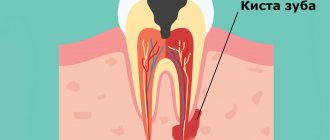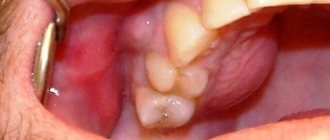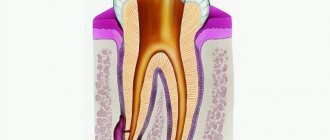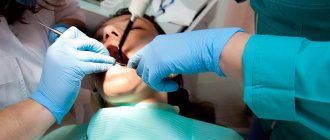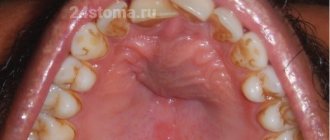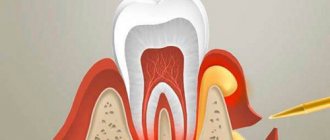What is a dental cyst?
Tooth cyst - what is it? An odontogenic cyst is a pathological neoplasm that occurs in the upper part of the tooth root. The internal cavity of the cyst is filled with liquid or mushy purulent contents; it is enveloped by a dense layer of epithelium.
The size of the cyst starts from a few millimeters, with rapid development reaching several centimeters in circumference. Most often, the pathological process affects the upper jaw, since the roots of its teeth have a more porous structure.
In order to understand what a dental cyst is and how to treat it, you need to know why such a phenomenon occurs. The formation of cysts occurs as a result of inflammation, thus the body restricts healthy tissue from the affected areas, clogging them along with bacteria into bubbles.
Causes
There are several reasons why a dental cyst develops. The main reason is the activity of pathogenic microorganisms in a closed dental space; the following risk factors contribute to this:
- severe pathology, lack of timely treatment and incorrect treatment of dental diseases - caries, periodontitis, pulpitis;
- infectious complications after tooth filling, implantation procedures - in such cases, the doctor removes not only the cyst, but also the crown or implant, this avoids relapse;
- complications during teething, especially when wisdom teeth erupt - dental tissues injure the gums, bacteria get into microcracks,
- microorganisms also enter wounds that form due to mechanical damage to teeth;
- Nasopharyngeal diseases – infections in the nose and throat can spread to the oral cavity.
To provide adequate treatment, it is necessary to accurately determine the cause of the development of a dental cyst; based on it, the dentist will prescribe suitable therapy. So, in cases of injury, treatment consists of removing the cyst and tissue regeneration, but if the cyst is a complication of another disease, then in addition to removing the vesicle, the patient will be prescribed treatment for the underlying disease.
Types of dental cysts
Tooth cysts have different classifications, each of which is formed according to certain characteristic parameters of the pathology.
According to the nature of the disease, they are distinguished:
- residual cysts – occur after tooth resection (removal) surgery; this is the most common type of cyst;
- retromolar – formed during severe eruption of wisdom teeth;
- radicular - cysts are located on or near the tooth root;
- follicular – at the heart of such cysts is the germ of a permanent tooth; follicular neoplasms arise as a result of poor quality care of baby teeth.
Classification of neoplasms according to their origin:
- odontogenic – arise as a result of the transition of the inflammatory process from other dental diseases;
- non-odontogenic - the causes of the development of such cysts include problems not related to the teeth and oral cavity.
Locations of cystic formation:
- anterior teeth;
- teeth that are adjacent to the nasal sinuses with their roots;
- wisdom teeth.
Chronic endometritis and pregnancy
As mentioned earlier, with chronic endometritis, infertility or recurrent miscarriage is often observed. It is necessary that the endometrial layer is constantly regenerated: only then will the embryo be successfully implanted into the uterus. In chronic endometritis, regeneration is impossible due to the inflammatory process, so the fertilized egg cannot attach to the endometrium.
Even if this happens, the pregnancy is rarely successful: the risk of miscarriage will continue throughout pregnancy. Such a pregnancy is accompanied by disorders and complications: in particular, pathogens can infect fetal tissue, which will lead to its death.
Impaired embryo development is another possible consequence of pregnancy with endometritis. The damaged endometrium lacks blood supply due to stagnation: the tissue does not receive oxygen, vitamins, nutrients and does not transfer them to the embryo. Because of this, the child may be born with pathologies. In addition, the likelihood of premature birth increases several times; the formation of the placenta may be disrupted, so when planning a pregnancy, treatment for this disease should be started immediately.
In total, miscarriages and infertility due to chronic endometritis are associated with several reasons:
- Violation of the morphology of the endometrium, due to which the fertilized egg is not fixed in the uterus and is released along with the discharge - in this case, the woman may not even know that she was pregnant.
- Problems with progesterone synthesis: This hormone maintains pregnancy by thickening the endometrium and preparing the uterine lining. In chronic endometritis, progesterone is produced poorly, and pregnancy is terminated early.
- Male sperm are inactivated already at conception. During inflammation, phagocytic cells of the body destroy foreign bodies, which are also mistaken for sperm.
Therefore, before planning a pregnancy, it is necessary to undergo a full course of treatment for endometritis: in this case, the probability of becoming pregnant can increase to 100%. In the case of IVF, the main problem is related to the fixation of germ cells in the uterus, so for efficiency it is worth making several attempts to implant a fertilized egg. In addition to taking medications, you need to take care of yourself: try to eliminate stress, limit physical activity and not lift heavy objects.
Symptoms
The danger of a dental cyst lies in the fact that signs of pathology appear only when the neoplasm reaches a relatively large size. In the early stages, small cysts do not manifest themselves in any way, meanwhile the infectious process covers an increasingly larger area of healthy tissue. In the initial development of pathology, cysts are discovered by chance during routine examinations or treatment of other diseases.
The duration of the formation of a dental cyst takes only 1-2 days; as it develops, the following symptoms may occur:
- unpleasant and even painful sensations in the tooth, which intensify when chewing solid food;
- protrusion of the gum of a tooth, in the area of the root of which a cyst forms, the growth of the gum becomes larger over time, redness is observed;
- the formation of a fistula in the area above the root of the tooth, the release of serous or purulent accumulations from it;
- general weakness and malaise;
- increase in body temperature.
Note! When a dental cyst occurs, the symptoms are not immediately visible; they appear in the later stages of development. The pain when a tumor appears is aching in nature, but it is less pronounced than the pain caused by caries and pulpitis.
If a clinical picture occurs and you suspect a pathological process, be sure to consult a doctor. Under no circumstances should you resort to self-treatment - the dental cyst must be removed. In addition, taking the wrong medications can worsen the patient’s overall well-being.
Sometimes there is no pain in the oral cavity; instead, the basis of the clinical picture is intense headaches. The cause of this phenomenon may be a cystic formation in the maxillary sinus.
Treatment at home
To treat inflammatory processes in the gums, you can resort to home remedies.
Rinsing gums:
- Chlorhexidine. The medicine in the form of a solution is used to disinfect the oral cavity from harmful microorganisms. You need to rinse 5 times a day.
- Rotokan. A drug containing herbal ingredients. You need to rinse your mouth 3 times a day.
- Furacilin. Antibacterial mouth rinse every 2 hours.
Ointments and gels:
- Holisal. Copes with swelling, suppresses pain.
- Periodonticide. The composition contains vegetable oils. Apply to gums 2-3 times a day for 8-10 days.
- Heparin ointment. Helps achieve an anti-inflammatory effect. You need to rub it into your gums 2 times a day.
Medicinal toothpastes:
- Lakalut active. Reduces swelling and has an antiseptic effect.
- Parodontax. Copes with inflammatory reactions and swelling.
Gum massage
To improve blood flow in the gums, you can massage with a toothbrush while brushing your teeth or with your hands.
When massaging with your fingers, you need to stroke, rub, squeeze and squeeze the gums. It is worth doing a massage every day in the morning and evening.
Vitamins
In addition to treatment with ointments and gels, you should take care of taking vitamin supplements that will help maintain oral health. Inflammation of the gums may be associated with a lack of vitamins A, PP, D, as well as the minerals calcium and phosphorus.
Consequences
Without adequate treatment, the dental cyst continues to grow and develop; in advanced stages, large neoplasms destroy the bone tissue of the skull, as a result it is replaced by connective tissue formations, which leads to the development of the following complications:
- dissolution of the jaw bone, which depends on the growth of the cyst;
- the formation of pus in the cyst, further purulent inflammation can lead to the development of an abscess;
- inflammatory process of lymph nodes located near the source of infection;
- development of osteomyelitis or periostitis;
- development of chronic sinusitis when the cyst grows in the maxillary sinus;
- pathological fracture of the jaw bones when the cyst reaches a large size;
- development of phlegmon due to a long-term purulent inflammatory process in the cyst;
- sepsis – blood poisoning;
- degeneration of a cyst into a malignant tumor without timely treatment.
Many patients are interested in why a dental cyst appears in the maxillary sinus, how dangerous it is and its symptoms. The formation of a cyst of this type occurs as a result of untreated inflammation of the tooth root in the upper jaw. A granuloma forms at the root of the tooth, which increases in size and becomes a peri-radicular cyst, then takes a position in the maxillary sinus. The volume of such a cyst can reach 9-12 cubic centimeters.
The symptomatic picture includes painful sensations, the nature of which is similar to trigeminal neuralgia, pain in the occipital, temporal and parietal regions of the head. Externally, a dental cyst can be identified by the asymmetry of the face. Tooth cyst - photo shows a cyst in the maxillary sinus.
Inflammatory diseases of the female genital organs
Vulvitis is an inflammation of the mucous membrane of the vaginal vestibule. It develops mainly in girls. Infection is promoted by diaper rash, scratching, abrasions, endocrine pathology (IDDM), helminthic infestations, and childhood viral infections. In adults, as a rule, vulvitis is combined with inflammation of the vaginal mucosa.
Clinic: pain, swelling of the vulva, purulent discharge.
Bartholinitis is an inflammation of the large glands of the vaginal vestibule. Very often, if the rules of genital hygiene are not observed, various bacteria and STIs get into it. Its excretory duct becomes clogged and an inflammatory process occurs in the gland. Unilateral damage to the Bartholin gland is more common.
It first appears as redness around the external opening of the excretory duct, then inflammatory swelling can clog the gland duct, preventing the release of purulent secretion, which, lingering in the duct, stretches it, forming a false abscess (ulcer), which protrudes the inner surface of the labia majora and closes the entrance to the vagina . Body temperature and soreness in the perineal area may increase. In rare cases, the inflammatory process can directly involve the gland tissue, resulting in a true abscess with severe suppuration and enlargement of the gland. The labia majora and minora are swollen. The inguinal lymph nodes are enlarged. Body temperature rises. A true abscess differs from a false abscess by constant pain, severe swelling of the labia, immobility of the skin over the abscess, and high fever.
The abscess can spontaneously open with the flow of thick yellow-green contents, after which the condition improves. The inflammatory process can die out on its own (without suppuration). In this case, compaction and slight enlargement of the gland are observed. However, quite often after some time the inflammatory process resumes and becomes more complicated.
Colpitis is inflammation of the vagina (vaginitis).
The clinical picture includes a triad of symptoms: pain, leucorrhoea, itching.
Colpitis can be caused by gonococci, trichomonas, chlamydia, as well as conditionally pathogenic microorganisms such as staphylococci, streptococci, fungi of the genus Candida, E. coli, etc. There are acute and permanent vaginitis. During an acute process, women complain of itching in the area of the vaginal vestibule, burning, a feeling of pressure, heat in the genitals and pelvis, many note dysuric disorders. Characteristic is copious discharge - leucorrhoea. The inflammatory process caused by various pathogens has its own characteristics. For example, profuse, frothy, yellowish-green discharge with an unpleasant odor is characteristic of Trichomonas vaginitis; discharge of a white, curd-like appearance - for fungal. In chronic forms of inflammation, there is no pain; patients mainly complain of discharge, itching, burning, and small ulcerations in the area of the vaginal vestibule.
Bacterial vaginosis (diagnosed since 1980) Gardner's disease. The only complaints are about increased discharge of leucorrhoea (profuse discharge, foul-smelling). There are no symptoms of inflammation. Often women complain of discomfort and burning in the vagina. Recently, bacterial vaginosis has been considered as a kind of vaginal dysbacteriosis, which occurs when the number of lactobacilli secreting lactic acid decreases and the pH of the vaginal secretion increases (more than 4.5). This creates conditions for the massive proliferation of microorganisms such as gardnerella and obligate anaerobic bacteria. This disease is rare in prepubertal girls and postmenopausal women, indicating a significant hormonal component in causing this imbalance.
Cervicitis is an inflammation of the cervix, which occurs as a result of penetration of gonococci, trichomonas, chlamydia, staphylococci, streptococci and other bacteria, and less commonly viruses, into the cervical canal. The occurrence is facilitated by cervical ruptures during childbirth, prolapse of the genital organs, infectious processes in the vagina and, conversely, in the internal genital organs. In an acute process, a woman is bothered by mild pain in the lower abdomen, discomfort in the vagina, sometimes itching, mucous or purulent mucous discharge from the vagina, pain during sexual intercourse. In a chronic process, complaints are less pronounced.
Endocervicitis is an inflammation of the mucous membrane of the cervical canal. It can occur with the penetration of various bacteria (staphylococci, streptococci, gonococci, intestinal Escherichia, etc.). Endocervicitis is often combined with an inflammatory process in other parts of the reproductive system - colpitis, salpingoophoritis, cervical erosion.
Symptoms: mucopurulent vaginal discharge, no pain. Clinical signs are mild. In the acute stage, hyperemia around the external pharynx and mucopurulent discharge are determined. In the chronic stage there is almost no hyperemia, the discharge remains. With a long course of the process, hypertrophy (thickening) of the cervix develops - cervicitis
Condylomas acuminata (multiple growths on the surface of the external genitalia and vaginal opening). May spread to the perineum, vagina, cervix. The cause of condylomas is a filterable virus (human papillomavirus); the development of the process is facilitated by abundant discharge from the genital tract during colpitis and endocervicitis. Genital warts grow very quickly during pregnancy.
Symptoms: condylomas are most often localized on the external genitalia, perineum, and around the anus. In cases of necrosis of condylomas and the addition of a secondary infection, purulent discharge appears. Condylomas of the vagina and cervix during pregnancy and childbirth can cause bleeding. The diagnosis is made based on examination.
Diagnosis of tooth root cyst
To make a diagnosis and carry out appropriate treatment, the dentist collects and analyzes the medical history. During the initial diagnosis, many patients report the fact of endodontic treatment performed to eliminate periodontitis or pulpitis. Some patients indicate an exacerbation of the disease after intraoral dissection.
Radiography is used as the main diagnostic method. Below is a photo and x-ray of a dental cyst.
To obtain an x-ray, several methods are used, the first method is based on contact intraoral x-ray, the advantages of this technique:
- determining the degree of destruction of the jaw bones;
- assessment of the condition of the tooth root and tooth canal;
- assessment of the quality of canal filling;
- identifying the presence of perforations and fragments of instruments and materials in the tooth canal;
- determination of the relationship between the cyst and the roots located near the teeth.
The second method of performing radiography is an orthopantogram; the procedure is a panoramic photograph of both jaws and the maxillary sinuses of the upper jaw.
Another method of the procedure is a survey X-ray in the nasomental projection; the X-ray covers the bones of the skull from the nose to the chin; using the image, the doctor assesses the condition of the maxillary sinuses and detects cysts that have grown into the nasal cavity.
In addition to radiography, to detect a tumor, the patient may be prescribed an electroodontic diagnostic procedure. This technique helps to assess the degree of such an indicator as the electrical excitability of the teeth that are located next to the cystic tooth. If the value exceeds 60 microamps, the dentist prescribes endodontic treatment to the patient.
For diagnostic purposes, histological and cytological studies are used to determine whether the neoplasm is benign or malignant.
Diagnosing a dental cyst is not difficult, but only qualified dentists can carry it out in a hospital setting; under no circumstances try to independently determine the presence of a cyst and do not take therapeutic measures; strictly follow the doctor’s recommendations.
Treatment
Treatment of dental cysts is carried out through surgery, laser treatment and conservative therapy. The latter has a positive effect only in the initial stages of the disease; overgrown cysts must be removed.
Surgery
To eliminate the pathology, it is not necessary to remove the entire tooth; only the tooth root on which the cyst is located is subject to resection. After removing the affected area, the dentist seals the remaining root, treats the surgical canal through which he removed the bladder with its contents, and stitches it up.
After a few days, the doctor removes the stitches and monitors the wound healing process. It is important to make sure that there are no cyst particles left in the dental canal; to achieve this goal, repeat radiography is performed.
Note! Sometimes it is impossible to remove the root along with the cyst; in these cases, the doctor completely removes the tooth. Indications for complete tooth resection are a difficult-to-reach location of the cyst and a severe course of the disease.
After surgical removal of a cyst, the patient must regularly visit the dentist and follow the recommendations prescribed by the doctor.
Conservative therapy
Tooth cyst - treatment of the disease with conservative methods is possible only in the early stages of its development. In order to eliminate the tumor, the patient is prescribed injections and rinses.
During therapeutic treatment, the dentist opens the dental canal, which leads to a cystic neoplasm, and pumps out exudate from it. The doctor does not fill the canal for ten days; during this period, the patient uses antiseptic solutions and tinctures to rinse the mouth.
Upon completion of the treatment course, the dentist treats the dental canal with medications and then fills the tooth.
Laser removal
Laser treatment is a modern method of treating dental cysts. When performing the method, the doctor opens the dental canal and uses laser irradiation to treat the area where the cystic tumor is located. The laser destroys not only the epithelium of the cyst, but also hundreds of thousands of bacteria that are inside the bladder.
The advantages of laser removal are rapid tissue healing and no risk of secondary infection in the oral cavity and dental canal.
Treatment with antibiotics
In some cases, dental cysts are treated with antibiotics. Taking antibacterial drugs is an auxiliary measure to destroy an expanded infection or the main method of treatment if a dental cyst develops against the background of a primary infectious disease.
Antibacterial drugs can only be prescribed by the attending physician; the following drugs are most often used:
- amoxicillin – has a high antibacterial effect, greatly facilitates the treatment of cysts with other methods;
- Cifroploxacin is a broad-spectrum antibiotic that actively destroys bacteria and relieves inflammation;
- tetracycline - this drug is prescribed more often than others, it actively relieves the inflammatory process, pain syndrome, and facilitates other methods of treating dental cysts.
Sometimes a doctor can prescribe topical antibacterial agents to a patient, but taking such medications is not always advisable - local drugs - antibiotics are quite difficult to distribute evenly over the diseased area.
Note! Antibacterial drugs are potent drugs that also affect beneficial bacteria in the body. You can take such medications only as prescribed by a doctor, without increasing the number of doses or dosage.
Treatment at home
Treatment of dental cysts at home is possible only as an auxiliary therapy. A cyst should not be confused with a granuloma; the latter can resolve on its own, but the cystic formation must be radically removed. Home treatment is not used to remove the cyst, but to eliminate the inflammatory process and destroy harmful bacteria.
The main goal of therapy at home is to provide an antiseptic effect. Propolis tincture, calendula tincture, eucalyptus tincture have an antiseptic effect. Tinctures are used as follows: a small amount of medicine is applied to a cotton swab and applied to the affected area, held for 5-10 minutes.
Medicines with an antiseptic effect can be used before surgery to remove a cyst and after tooth root removal. The antiseptic effect allows these medications to be used in the treatment of caries and other infectious diseases of the oral cavity.
Prevention
It is always easier and faster to prevent any disease than to cure it, so one should not forget about simple preventive rules that will help avoid the development of a dental cyst. The basic rules for preventing dental cysts are based on compliance with the rules of oral care.
How to prevent the formation of pathology:
- do not trigger the course of dental diseases such as caries, periodontitis, pulpitis; if infections occur, consult a doctor immediately;
- Brush your teeth daily and prevent the appearance of plaque, which can later transform into tartar;
- monitor the condition of the teeth and oral cavity after operations and mechanical injuries;
- visit your dentist regularly;
- monitor the condition of filled teeth and dental implants;
Patients who have had their teeth filled or have dental crowns or implants placed are advised to periodically have dental x-rays taken. This will allow timely detection of pathological changes and increase the chances of successful recovery without serious consequences.
Note! All diseases must be treated in a timely manner; inflammatory processes reduce immunity, as a result of which infections move freely from one organ to another; in addition, secondary infections can be added to already developed pathologies. It is important to monitor your health and strengthen local and general immunity.
To strengthen your immune system, strengthen your body, include fresh fruits and vegetables in your diet, play sports and walk outdoors more often. It is more difficult for any infection to get into a hardened body than into a weakened body.
Treatment of periodontal disease at home
Eliminating dental disease at home is also possible. The patient must adhere to all medical recommendations and use prescribed means to strengthen the roots of the teeth. Dental care from a qualified periodontist must be combined with rinsing with various solutions - the doctor will help you choose the most effective ones in your case.
In our clinic you can undergo a full examination of your teeth and surrounding tissues without the risk of infection. Each specialist at our clinic cares about the oral health of their patients. We will always provide competent professional dental care.
Experts strongly recommend not to forget about maintaining dental health!
